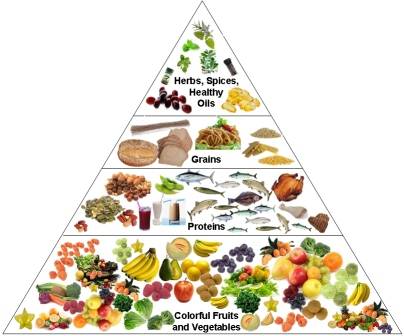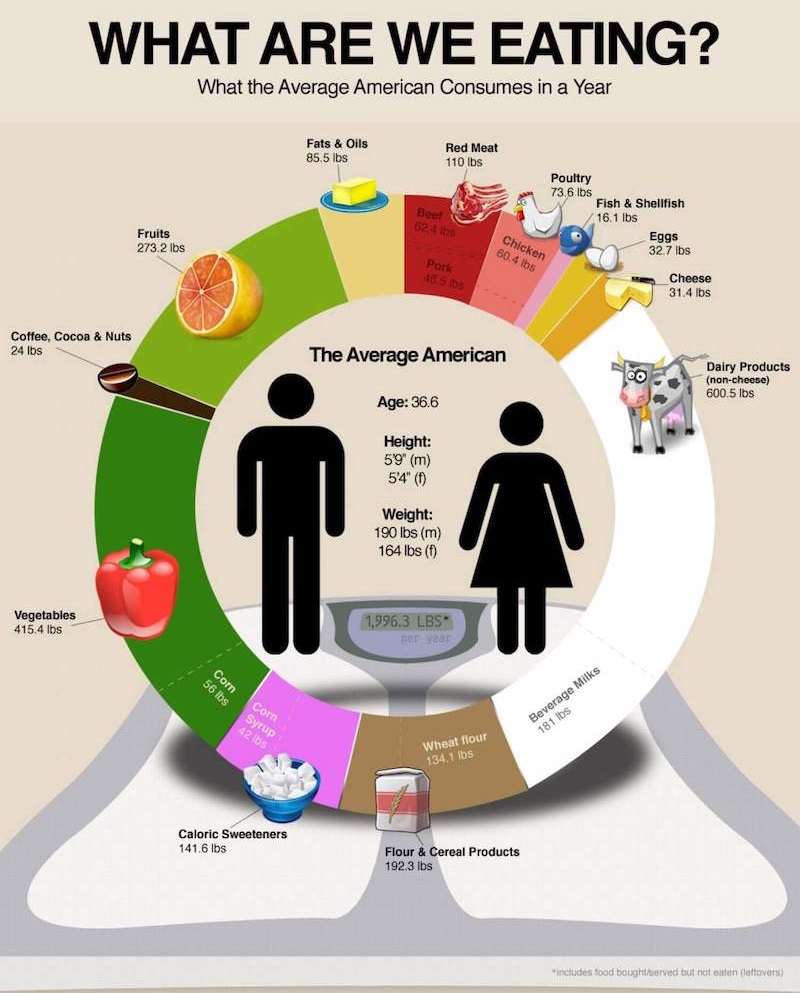"Let food be your medicine" - Hippocrates
Diet and lifestyle changes can prevent 70-90% of certain common degenerative diseases. Among U.S. adults, more than 90% of type 2 diabetes, 80% of coronary artery disease (CAD), 70% of stroke, and 70% of colon cancer are potentially preventable by a combination of not smoking or being overweight, having some moderate physical activity and a healthy diet, and moderating alcohol consumption. Willett et al, 2006

The nutrition pyramid above is more healthful than the usually promoted pyramid, which has grains at its base.
| Detailed information | ||
|---|---|---|
| Fruit / Vegetables | Meat | Fish |
| Dairy | Eggs | Fats / Oils |
| Grains | Legumes | Nuts / Seeds |
| Herbs, spices, salt | Sweeteners | Beverages |
• Natural, unprocessed and organic (chemical/GMO-free). "Organic" - What does that mean?
• Grown in your native environment. i.e. locally grown and seasonal.
• Try to eat at least 1/3 of your food raw; Raw food contains enzymes, which are destroyed by heat. Some nutrients are made more bioavailable by heating, some are destroyed. How to cook to preserve nutrients.
In addition to saturated fat (includes grass-fed animal fats), you also need monounsaturated fats and polyunsaturated fats (We usually get plenty of omega-6 fat, but are desperately short-changing dietary Omega-3 fat). Eliminate expeller-pressed, typical grocery store polyunsaturated vegetable oils (e.g. soybean, corn, canola, cottonseed oils) and margarine - they are toxic, even more so when used in high-heat cooking. This is a complicated topic, but to help you understand which fats to eat and why:
Food Fats and Oils EFAs - Fats of Life Some healthy recipes
Importance of body's balanced presence of Omega-3 and Omega-6 fats -Today's "HOLY GRAIL" of Health
• Vitamins. Water-soluble B and C, and fat-soluble A, D, E and K vitamins
• Phytonutrients. Carotenoids (e.g. beta-carotene in carrots, lutein, lycopene in tomatoes) and polyphenols (e.g. resveratrol in red wine, anthocyanins in sweet cherries and epicatechins in green tea / chocolate, quercetin in red onion)
• Other antioxidants. E.g. CoQ10, alpha lipoic acid
More than 2/3 of your immune system is on your gut and depends on a healthy presence of microflora.
Sufficient mineral intake. Of the 92 naturally occurring elements on earth, we need 40 of them of which most are the major and trace minerals. Some minerals are no longer present in sufficeint amounts in today's typical diet, including possibly magnesium, sulfur, selenium, zinc, manganese, which may need to be supplemented.
Foods containing high-energy electrons
A crucial body-building nutrient. Comprised of 23 amino acids, of which 15 are called essential amino acids, meaning they must be consumed in our diet because our body can't make them
Required to make cellular energy. The body can obtain glucose from carbohydrates, proteins and fats
Unfortunately, in today's world, numerous
factors have caused a
depletion of available nutrients in our food supply.
Therefore,
unless you have food sources from reliable nutrition-minded food producers, or are
responsibly growing your own food or keeping animals and birds for meat and eggs,
it has become necessary to include some daily supplements to ensure needed nutrients:
Daily Nutritional Supplement Chart
Consume little or no added sugar. Except such as a small amount of honey, maple syrup or molasses or use alternative natural low/no caloric sweeteners such as erythritol or stevia; avoid unhealthy artificial sweeteners, such as Nutrasweet™ and Splenda™.
Antinutrients. Particularly lectins and phytate in IMPROPERLY prepared WHOLE grains, seeds, nuts and legumes. Lectins can cause a "leaky gut" / inlflammation leading to IBS, allergies, asthma, arthritis, anemia, obesity, +++ ; Phytate can cause malabsorption of magnesium, calcium, iron, copper, and zinc;
Other substances to avoid / minimize
Alcohol
"Teacher, which is the greatest commandment in the Law? 'Love the Lord your God with all your heart and with all your soul and with all your mind.'This is the first and greatest commandment. And the second is like it: 'Love your neighbor as yourself.'All the law and the Prophets hang on these two commandments." Matthew 22:36-40
This author believes that Christ's sacrifice on the cross abolished the need for us to obey the O.T. Mosaic Book of the Law (noting however, that it is still important to God that we keep his 10 commandments [which are essentially - love God / love people] - as written with His own finger on stone tablets --- (1) to authenticate our faith and (2) because Jesus told us to do so). However, by studying the O.T. Book of the Law (written by Moses under God's direction), it is soon realized that those laws relating to our health were not just a list of arbitrary instructions, but rather were intended as a blessing to protect and enhance spiritual, emotional, social and physical health. As such, a person would be wise to re-evaluate those instructions.
It is a shocking fact that ~90% of the money spent on food in the U.S. is spent on processed foods (Fast Food Nation by Eric Schlosser, 2002, Penguin Books). Most of us eat and drink only for enjoyment and sustenance, giving little attentionto whether we are obtaining needed nutrients in the correct balance to maintain health. Although America is the richest country in the world, it takes the "prize" for having the highest obesity rate (30% of the population). With some effort, however, it is possible to make healthy choices that also fulfill our desire for pleasure when filling our tummies.
According to 2011 USDA data, the average American eats almost 1 ton of food per year (includes food bought, served but not eaten) - our average 2700 calories/day includes our annual consumption of 23# pizza, 24# ice cream, 53 gals. soda, and 24# artificial sweeteners. We do eat 415# vegetables, but many of those pounds are french fries and starchy corn.

Photo credit: Daily Infographic
Willett WC, Koplan JP, Nugent R, et al. Prevention of Chronic Disease by Means of Diet and Lifestyle Changes. In: Jamison DT, Breman JG, Measham AR, et al., editors. Disease Control Priorities in Developing Countries. 2nd edition. Washington (DC): The International Bank for Reconstruction and Development / The World Bank; 2006. Chapter 44. Available from: https://www.ncbi.nlm.nih.gov/books/NBK11795/ Co-published by Oxford University Press, New York.